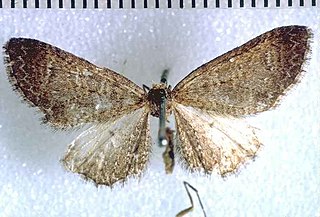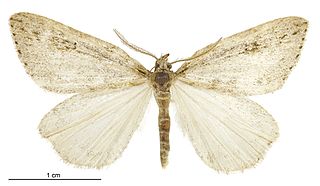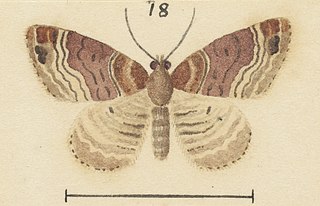Platyptilia hokowhitalis is a species of moth in the family Pterophoridae. This species is endemic to New Zealand. This species has been classified as Data Deficient by the Department of Conservation.

Pasiphila acompsa is a moth in the family Geometridae. It was described by Louis Beethoven Prout in 1927. It is endemic to New Zealand and has been observed in mountainous locations in both the North and South Islands. Larvae of this species have been reared on plants within the Veronica genus. Adults are on the wing from December to February.

Orocrambus ornatus is a moth in the family Crambidae. This species is endemic to New Zealand. It is classified as critically endangered by the Department of Conservation.

Thambotricha is a monotypic genus of moths in the family Epermeniidae. Its sole known species, Thambotricha vates, is also known by the vernacular name wonder-haired prophet. It is endemic to New Zealand. This species is classified as "At Risk, Naturally Uncommon" by the Department of Conservation.

Kiwaia pumila is a moth in the family Gelechiidae. It is endemic to New Zealand. It is classified as Nationally Vulnerable by the Department of Conservation.

Pseudocoremia albafasciata, also known as the flash moth, is a species of moth in the family Geometridae. It is endemic to New Zealand. It is classified as Nationally Endangered by the Department of Conservation.

Pseudocoremia cineracia is a species of moth in the family Geometridae. It is endemic to New Zealand. It is classified as Nationally Vulnerable by the Department of Conservation.

Pseudocoremia fluminea is a species of moth in the family Geometridae. It is endemic to New Zealand. It is classified as Not Threatened by the Department of Conservation.

Gingidiobora nebulosa, the gingidium looper moth, is a moth in the family Crambidae. It is endemic to New Zealand. This species has been classified as Nationally Vulnerable by the Department of Conservation.

Helastia expolita is a moth of the family Geometridae. This species is endemic to New Zealand and occurs in the Buller, Marlborough, North and Mid Canterbury regions.This species inhabits short tussock grassland in montane to subalpine zones. Adult moths are nocturnal but little is known about the life history of H. expolita. Adults have been observed on the wing in November. It has been hypothesised the larvae of H. expolita feed on the flowers of Helichrysum species and then feed on mosses, lichens or shrubs growing nearby. It is classified as "At Risk, Relict'" by the Department of Conservation.

Meterana exquisita is a species of moth in the family Noctuidae. This species is endemic to New Zealand. It is classified as "At Risk, Relict'" by the Department of Conservation.

Meterana grandiosa is a species of moth in the family Noctuidae. This species is endemic to New Zealand. It is classified as "At Risk, Relict'" by the Department of Conservation.

Hydriomena iolanthe is a species of moth in the family Geometridae. It is indigenous to New Zealand. This species is based on a single specimen that is now lost and has not been matched to any known species. As such it is classified as data deficient by the Department of Conservation.

Tingena loxotis is a species of moth in the family Oecophoridae. This species is endemic to New Zealand and is found in the North Island. This species is found in gardens and are known to enter houses. Adults are on the wing in December and January. It is classified as "Data Deficient" by the Department of Conservation.

Ichneutica panda is a species of moth in the family Noctuidae. It is endemic to New Zealand and only found in central and southern parts of the South Island. The species has not been collected in Canterbury since the late 1950s and has not been seen at The Wilderness scientific reserve since 1941. This species is similar in appearance to Ichneutica falsidica however I. panda lack or have indistinct black dashes on their edge of their hindwings. I. panda inhabit shrubland from alpine zones down to river terraces and adults are on the wing between December and February. The life history of this species is unknown as is the host species of the larvae.

Asaphodes glaciata is a species of moth in the family Geometridae. This species is endemic to New Zealand. This moth has only be found in Westland in the areas near Fox and Franz Josef Glaciers. Adults of this species are on the wing in January.

Notoreas arcuata is a species of geometer moth endemic to New Zealand. This species if found in the South Island and has been observed in the Saint Arnaud Range, around Arthur's Pass and in the Oteake Conservation Park. Larvae feed on species in the genera Kelleria and Pimelea. Adults are on the wing from December to February.

Tingena thalerodes is a species of moth in the family Oecophoridae. It is endemic to New Zealand and has been found at Arthur's Pass. This species inhabits rough herbage on mountain sides. Adults are on the wing in December and January.

Dasyuris fulminea is a species of moth in the family Geometridae. It was first described by Alfred Philpott and is endemic to New Zealand. It has been observed in the regions of the West Coast, Fiordland and Otago. Adults are day flying and are on the wing from December until February.

Pseudocoremia lupinata is a species of moth in the family Geometridae. It is endemic to New Zealand and can be found in both the North and South Islands. The favoured habitat of this species is Kānuka scrubland as its larval hosts are species in the genus Kunzea. Both the larvae and adults of this species are nocturnal. Adult moths are commonly on the wing from December to June and are attracted to light.




















